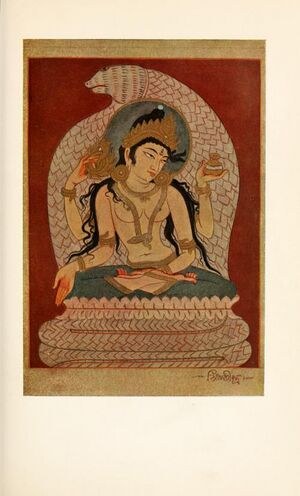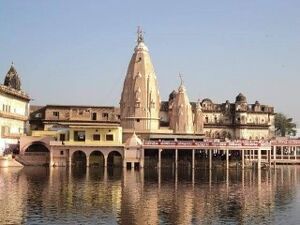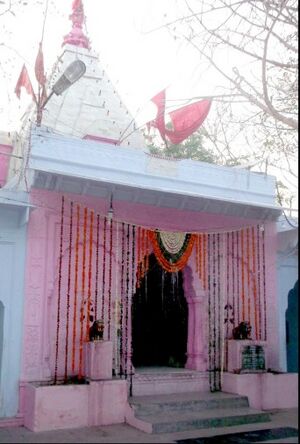Mansa Mata

Mansa Mata (मनसा माता) or Mansa Devi (मनसा देवी) or Manasa (मनसा) is a goddess of snakes annd folk-deity of Hindus. Vasuki (वासुकि) or Basuki (वासुकि) was a Naga, The king of Patalaloka, born in Nagavansh. Manasa Devi was Vasuki's sister and wife of sage Jagatkāru (Jaratkāru).[1] Manasa Devi took up her abode on earth with another daughter of Shiva, named Neta. [2]
Worship of Mansa Devi
Manasa is ceremonially worshipped on Nag Panchami. Generally, Manasa is worshipped without an image. A branch of a tree, an earthen pot or an earthen snake image is worshipped as the goddess,[3] She is worshipped for protection from and cure of snake bites and infectious diseases like smallpox and chicken pox. Mansa Devi is worshipped mainly in Bengal and other parts of North and northeastern India, chiefly for the prevention and cure of snakebite and also for fertility and prosperity.
These festivities of Manasa Puja sometimes occupy a whole month . . . how widespread is the popularity of these songs in Bengal may be imagined from the fact that the birthplace of Chand Sadagar is claimed by no less than nine districts " and by the fact that the Manasa Mangal, or Story of Manasa, has been told in as many as sixty versions by poets whose names are known, dating from the twelfth century onward to the present day. "
Manasa is the sister of Vasuki, king of Nāgas and wife of sage Jagatkāru (Jaratkāru).[4] She is also known as Vishahara (the destroyer of poison), Nityā (eternal) and Padmavati.[5]
Her myths emphasize her bad temper and unhappiness, due to rejection by her father Shiva and her husband, and the hatred of her stepmother, Chandi (Shiva's wife, identified with Parvati in this context). In some scriptures, sage Kashyapa is considered to be her father, rather than Shiva. Manasa is depicted as kind to her devotees, but harsh to people who refused to worship her.[6] Denied full godhead by her mixed parentage, Manasa’s aim was to fully establish her authority as a goddess and to acquire steadfast human devotees.[7]
Origin
Manasa first appears in the Hindu text Atharva Veda as a snake goddess. In the Puranas, she was recognized as a daughter of sage Kashyapa and Kadru, the mother of all Nāgas.
By the 14th century, Manasa was identified as the goddess of fertility and marriage rites and was assimilated into the Shaiva pantheon as a relative of Shiva. Myths glorified her by describing that she saved Shiva after he drank poison, and venerated her as the "remover of poison". Her popularity grew and spread to southern India, and her cult began to rival Shaivism itself. As a consequence, stories attributing Manasa's birth to Shiva emerged and ultimately Shaivism adopted this indigenous goddess into the Brahmanical tradition of mainstream Hinduism.[8]
Her depiction
Manasa is depicted as a woman covered with snakes, sitting on a lotus or standing upon a snake. She is sheltered by the canopy of the hoods of seven cobras. Sometimes, she is depicted with a child on her lap. The child is assumed to be her son, Astika.[9][10]
Manasa as daughter of Shiva
Sister Nivedita and Anand K. Coomaraswamy[11] write that Manasa Devi was the daughter of Shiva by a beautiful mortal woman. She was no favourite of her step mother, Bhagavati, or Parvati, Shiva's wife ; so she took up her abode on earth with another daughter of Shiva, named Neta. Manasa desired to receive the worship due to goddesses; she knew that it would be easy to obtain this if she could once secure the devotion of a very wealthy and powerful merchant-prince of Champaka Nagar, by name Chand Sadagar. For a long time she tried to persuade him ; but he was a stout devotee of Shiva him self, whom he was not going to desert for a goddess of snakes. .... This legend of Manasa Devi, the goddess of snakes, who must be as old as the Mykenean (Mycenaean Greece refers to the last phase of the Bronze Age in Ancient Greece (c. 1600–1100 BC).) stratum in Asiatic culture, reflects the conflict between the religion of Shiva and that of feminine local deities in Bengal. Afterwards Manasa or Padma was recognized as a form of Shakti , and her worship accepted by the Shaivas. She is a phase of the mother-divinity who for so many worshippers is nearer and dearer than the far-off and inpersonal Shiva, though even he, in these popular legends, is treated as one of the Olympians with quite a human character.
Manasa as daughter of Kashyapa
According to Puranas sage Kashyapa is her father, not Shiva as described in the Mangalkavyas. Kashyapa married Manasa to sage Jaratkaru, who agreed to marry her on the condition that he would leave her if she disobeyed him. Once, when Jaratkaru was awakened by Manasa, he became upset with her because she awakened him too late for worship, and so he deserted her. On the request of the great Hindu gods, Jaratkaru returned to Manasa and she gave birth to Astika, their son.[12]
In Mahabharata
Manasa's marriage: The Mahabharata tells the story of Manasa's marriage. Sage Jagatkāru practiced severe austerities and had decided to abstain from marriage. Once he came across a group of men hanging from a tree upside down. These men were his ancestors, who were doomed to misery as their children had not performed their last rites. So they advised Jagatkāru to marry and have a son who could free them of those miseries by performing the ceremonies. Vasuki offered his sister Manasa's hand to Jagatkāru. Manasa mothered a son, Astīka, who freed his ancestors. Astika also helped in saving the Nāga race from destruction when King Janamejaya decided to exterminate them by sacrificing them in his Yajna, fire offering.[13]
Adi Parva, Mahabharata/Mahabharata Book I Chapter 57 mentions the names of all those Nagas that fell into the fire of the snake-sacrifice. Nagas born of Vasuki includes Manasa.[14]
Sabha Parva, Mahabharata/Book II Chapter 25 mentions that Arjuna after crossing the White mountains, subjugated the country of the Kimpurushas ruled by Durunaputra, after a collision involving a great slaughter of Kshatriyas, and brought the region under his complete sway. Having reduced that country, the son of Indra (Arjuna) with a collected mind marched at the head of his troops to the country called Hataka (हाटक), ruled by the Guhyakas (गुह्यक). Subjugating them by a policy of conciliation, the Kuru prince beheld (in that region) that excellent of lakes called Manasa[15] and various other lakes and tanks sacred to the Rishis. And the exalted prince having arrived at the lake Manasa[16] conquered the regions ruled by the Gandharvas that lay around the Hataka territories. Here the conqueror took, as tribute from the country, numerous excellent horses called Tittiri, Kalmasha, Manduka. At last the son of the slayer of Paka, arriving in the country of North Harivarsha desired to conquer it.
मनसादेवी शक्तिपीठ
शिव पुराण में इसका वर्णन मिलता है कि एक बार सती के पिता दक्ष प्रजापति ने यज्ञ का आयोजन किया। इस अवसर पर सती व उसके पति शिव के अतिरिक्त सभी देवी-देवताओं व ऋषि-मुनियों को बुलाया गया। जब सती को इस बात का पता चला तो वह अनुचरों के साथ पिता के घर पहुंची। तो वहां भी दक्ष ने उनका किसी प्रकार से आदर नहीं किया और क्रोध में आ कर शिव की निंदा करने लगे। सती अपने पति का अपमान सहन न कर पाई और स्वयं को हवन कुंड में अपने आप होम कर डाला। भगवान शिव जब सती की मृत देह को लेकर ब्राह्मांड में घूमने लगे तो भगवान विष्णु ने अपने सुदर्शन चक्र से सती के शरीर को 52 हिस्सों में बांट दिया। जहां-जहां सती के अंग गिरे वहां-वहां पर शक्ति पीठ स्थापित हुए। कांगड़ा के स्थान पर माता का वक्षस्थल गिरा था जिसके कारण माता वज्रेश्वरी कहलाई। इसी प्रकार कलकत्ता मे केश गिरने से महाकाली, असम मे कोख गिरने से कामाख्या, मस्तिष्क का अग्रभाग गिरने से मनसा देवी, जिह्वा गिरने से ज्वालामुखी देवी, सहारनपुर के पास शीश गिरने से शाकम्भरीदेवी, ब्रह्मरंध्र गिरने से हिंगलाज देवी आदि शक्तिपीठ भक्तों की आस्था के केन्द्र बन गये।
बिजारनियाँ जाटों का राज्य
11 वीं सदी में वर्तमान पलसाना कस्बे के दक्षिण पश्चिम में स्थित छोटी पर्वत चोटी लढाणा के ऊपर विजयरणीय जाटों का वैभव चरम पर था उनके गढ़ों के ध्वस्त अवशेष इस कहानी को अब भी एक अदृश्य इतिहास के रूप में प्रदर्शित कर रहे हैं I विजयरणीय आज अपभ्रंश होकर बिजारनियाँ अथवा बिजारणियाँ हो गए हैं और पलसाना के इर्द-गिर्द बड़ी मात्रा में अब भी आबाद हैं। एक वंशावली संग्रहण प्रपत्र 21 अक्तूबर-2015 को मनसा माता मंदिर के जीर्णोद्दार कार्यक्रम में वितरित किया गया है जिसमें विजय रणीय जाटों के विवरण आमंत्रित किए गए हैं ये विवरण इस ई मेल पते पर भी भिजवाए जा सकते हैं:-
blbijarniyan@gmail.com
प्रसिद्ध बिजारनिया जाट
यहीं पास में वह गाँव गोवर्धनपुरा भी है जिसके गौरव चौधरी लादूराम बिजारनियाँ खंडेला क्षेत्र से 1952 में विधायक तो चुने ही गए इससे पूर्व उन्होने वो ऐतिहासिक कार्य किया जो अब तक किसी के नाम दर्ज नहीं है यानि जघीना (भरतपुर) के ठाकुर देशराज सोगरवाल द्वारा लिखित "जाट इतिहास" का 1934 के "सीकर जाट महायज्ञ" में बसंत पंचमी के दिन विमोचन करवाया था और यह इतिहास जाट इतिहास लेखकों की श्रेणी में सबसे अधिकृत और सबसे सटीक तथ्यों पर आधारित है और सभी इतिहास की पुस्तकों में अब तक की सर्वश्रेष्ठ कृति के रूप में जानी जाती है।
इनके बाद बिजारनियाँ जाटों के 2 और विधायक बाप और बेटे बने हैं वे हैं ग्राम मुंडियागढ़ के रहने वाले पूर्व फुलेरा विधायक स्व. लक्ष्मीनारायण "किसान" और वहीं से निर्वाचित उनके पुत्र पूर्व विधायक श्री रामनारायण "किसान" इन दोनों ने अपने गोत्र के बजाय "किसान" उप नाम से सरकारी अभिलेख में नाम लिखवाए इसलिये अधिकांश जाटों को विदित ही नहीं है कि ये बिजारनियाँ गोत्र के थे गाँव मुंडियागढ़ वर्तमान जयपुर जिले की फुलेरा तहसील के बड़े कस्बे जोबनेर के नजदीक बसा हुआ अति पुराना और ऐतिहासिक गाँव है।
इस गोत्र में समाज सेवा की भावना कूट-कूट कर भरी होती है यही कारण है कि गौवर्धनपुरा के जन्मे चौ. लादूराम बिजारनियाँ ने कलकत्ता रहकर अपने इलाक़े में "जाट इतिहास" छपवा कर उसके विमोचन का श्रेय ले लिया जिसका विमोचन तत्कालीन हरयाणा प्रांत के सर छोटूराम (ओहलन गोत्री जाट) ने वर्तमान सीकर के जाट बोर्डिंग हाऊस वाले स्थल पर आयोजित "जाट महायज्ञ" में किया था और तब पहलीबार कोई जाट बालक हाथी पर निकले जुलूस में होदे पर बैठा था और वो भी एक हाथी को सीकर के जागीरदार द्वारा चुरा देने के बावजूद दूसरा हाथी मँगवा कर उस पर बैठा कर निकाला गया था।
मनसा माता के मंदिर
मनसा माता के नाम पर देश में अनेक मंदिर हैं खास तौर से हरियाणा और पंजाब में तथा राजस्थान में भी अनेक जगह पर हैं। यहाँ शौध का विषय यह है कि आखिर मनसा माता का इतिहास क्या है इस पर इतिहास मौन है अथवा कहीं कुछ यदादस्त दर्ज है ? इस बारे में और जानकारी की सभी बुद्धिजीवियों से हार्दिक अपील है कृपया जानकारी और इतिहास के बारे में अवगत कराएं।
- लढाणा के गढ़ को सिहा राम बिजारनियाँ नामक योद्धा ने बनवाया था और उसके पास छोटा सा मनसा माता का मंदिर भी बनवाया था जो इस गोत्र के जाटों की कुलदेवी मानी जाती है। इसी मंदिर के जीर्णोद्धार का बेड़ा 6 सितंबर-2014 को इस गोत्र के जाटों ने पलसाना में बैठकर उठाया था और अब 21 अक्तूबर-2015 को उसमें मूर्ति प्राणप्रतिष्ठा हो चुकी है जो मकराना में संगमरमर की बनी हुयी है। मूर्ति प्राण प्रतिष्ठा नरेना धाम(दादू पंथियों की मूल गद्दी) के महन्त स्वामी गोपाल दास(विजय रणीय गोत्री) के सानिध्य में पूर्व केंद्रीय मंत्री श्री सुभाष महरिया, पूर्व काबीना मंत्री-राजस्थान सरकार व पूर्व अध्यक्ष-प्रदेश कांग्रेस कमेटी तथा क्षेत्रीय विधायक चौधरी नारायण सिंह बुरड़क, पूर्व प्रधान पिपराली व मनसा माता सेवा समिति के संरक्षक श्री रामचंद्र सिंह बिजारनियाँ, लोसल(सीकर) नगर पालिका के पूर्व सभापति श्री गोविंद राम बिजारनियाँ, सुमित्रा मेमोरियल शिक्षण संस्थान, लोसल(सीकर) के अध्यक्ष श्री रणवीर सिंह बिजारनियाँ, अर्जुन शिक्षण संस्थान समूह, पूरा की ढान्णी(सीकर) के अध्यक्ष डॉ. भागीरथमल बिजारनियाँ,सीकर जिला युवा जाट महासभा के अध्यक्ष श्री रवि बिजारनियाँ, सीकर जिला जाट महासभा के अध्यक्ष श्री रतनसिंह पिलानिया, उपाध्यक्ष श्री भँवर लाल बिजारनियाँ, रामकुमार बिजारनियाँ,खूड़ सरपंच श्री रिछपाल सिंह बिजारनियाँ, नेतड़वास सरपंच श्री रामदेव सिंह बिजारनियाँ व मनसा माता सेवा समिति, पलसाना के अध्यक्ष रामदेव सिंह बिजारनियाँ की उपस्थिति में हजारों नर नारियों के जयकारों के साथ सम्पन्न हुआ I स्थानीय विधायक ने अपने विधायक कोटे से जीणमाता-पलसाना सड़क से लेकर मंदिर तक संपर्क सड़क बनाने हेतु 20 लाख रुपए देने की भी घोषणा की जिसका उपस्थित श्रद्धालुओं ने करतल ध्वनि से स्वागत किया I इस अवसर पर वृक्षा-रोपण का वृहद कार्यक्रम चलाने की भी समिति की ओर से घोषणा की गई I
- मनसा देवी चूरु
- मनसा माता झुन्झुनूं
- माता मनसा देवी मंदिर , पंचकुला, चंडीगढ़
- मनसा देवी मंदिर, हरिद्वार
- मां मंशा देवी मंदिर, गोपालपुर गांव मथुरा
मनसा माता मंदिर मथुरा

This is the famous temple of Mansa Devi in Mathura, which was reconstructed by Tomar Jat ruler Raja Hathi Singh after defeating the forces of Aurangzeb.
यह मथुरा में मनसा देवी का प्रसिद्ध मंदिर है, जिसे तोमर हिंदू जाट शासक राजा हाथी सिंह ने औरंगजेब की सेनाओं को हराने के बाद फिर से बनवाया था।
पांडव वंश की कुलदेवी हैं मां मंशा देवी

खुटैल पट्टी की आराध्य कुल देवी मां मंशा देवी के मंदिर का इतिहास महाभारत काल से जुड़ा है। मंदिर पर चैत्र शुक्लपक्ष की त्रयोदशी से पूर्णमासी तक मेला लगता है। देश-विदेश में बसे खुटैल वंश के लोग अपने बच्चों का मुंडन संस्कार इन्हीं दिनों में मंशा देवी के चरणों में आकर कराते हैं। मंशा देवी का मंदिर मथुरा-भरतपुर मार्ग पर गोपालपुर गांव के निकट पीली मिट्टी के 50 फीट ऊंचे एक हजार वर्ग मीटर के चबूतरे पर बना है। मंदिर में अंकित शिला लेख से पता चलता है कि इस का निर्माण पांडवों की 71वीं पीढ़ी में जन्मे जाट राजा सम्राट अग्नपाल नाग ने विक्रम सवत् 1094 (=1038 ई.) को फागुन मास की पंचमी को कराया था।
राजा अग्नपाल को मंशा देवी ने स्वप्न में मंदिर निर्माण की बात कही थी। राजा अग्नपाल के दरबार में एक बार महर्षि वेद व्यास आए। मां की पूजा से प्रेरित होकर उन्होंने राजा से वरदान मांगने को कहा। राजा ने दो वरदान मांगे। पहला वरदान पुत्र प्राप्ति और दूसरे में राज्य अटल रहे। वेद व्यास ने पुत्र के वरदान के साथ एक बबूल की एक लकड़ी महल के बीचों बीच गाढ़ दी और कहा कि राजन तेरा राज्य अटल हो गया। यह खूंटी भगवान शेषनाग की फन पर टिकी है।
राजा को भ्रम हो गया कि खूंटी शेषनाग के फन पर पहुंच गई। राजा ने भ्रम वश उसे उखाड़ दिया तो देखा कि खूंटी की नोंक पर खून लगा है। राजा इसे देख घबरा गया। बताते हैं कि सम्राट अग्नपाल के आठ पुत्र हुए। उन्होंने आठ गढ़ बनाए जो आज भी खुटैली के आठ खेरों के नाम से जाने जाते हैं।
खुटैल वंश उन्हीं पुत्रों की संतान है। खुटैल वंश अपनी आराध्य कुल देवी मंशा की पूजा करता चला रहा है। मंदिर का दोबारा निर्माण खुटैल पट्टी के लोगों ने कराया। देवी मंदिर के मुख्यद्वार पर राजा अग्नपाल की भव्य प्रतिमा स्थापित की जो देवी के सामने हाथ जोड़े हैं।
संदर्भ: अमर उजाला मथुरा 04 Apr 2017
References
- ↑ Wilkins p.395
- ↑ Sister Nivedita and Anand K. Coomaraswamy : Myths and Legends of the Hindus & Buddhists/CHAPTER VII,p.322
- ↑ Wilkins p.395
- ↑ Wilkins p.395
- ↑ Dowson, John (2003). Classical Dictionary of Hindu Mythology and Religion, Geography, History. Kessinger Publishing. p. 196. ISBN 0-7661-7589-8.
- ↑ McDaniel p.148
- ↑ Radice, William (2001). Myths and Legends of India. Viking Penguin Books Ltd. pp. 130–8. ISBN 978-0-670-04937-0.
- ↑ Tate, Karen (2005). Sacred Places of Goddess: 108 Destinations. CCC Publishing. p. 194. ISBN 1-888729-11-2.
- ↑ Wilkins p.395
- ↑ Chaplin, Dorothea (2007). Mythlogical Bonds Between East and West. READ BOOKS. p. 28. ISBN 9781406739862.
- ↑ Myths and Legends of the Hindus & Buddhists, p. 330
- ↑ Sharma, Mahesh (2005). Tales from the Puranas. Diamond Pocket Books (P) Ltd. pp. 38–40. ISBN 81-288-1040-5.
- ↑ Wilkins p.396
- ↑
- वासुकेः कुलजांस तावत परधान्येन निबॊध मे
- नीलरक्तान सितान घॊरान महाकायान विषॊल्बणान Mahabharata(I.57.4)
- कॊटिकॊ मानसः पूर्णः सहः पौलॊ हलीसकः
- पिच्छिलः कॊणपश चक्रः कॊण वेगः प्रकालनः Mahabharata(I.57.5)
- हिरण्यवाहः शरणः कक्षकः कालदन्तकः
- एते वासुकिजा नागाः परविष्टा हव्यवाहनम Mahabharata(I.57.6)
- ↑
- तांस तु सान्त्वेन निर्जित्य मानसं सर उत्तमम
- ऋषिकुल्याश च ताः सर्वा थथर्श कुरुनन्थनः Mahabharata (II.25.4)
- ↑
- सरॊ मानसम आसाथ्य हाटकान अभितः परभुः
- गन्धर्वरक्षितं थेशं वयजयत पाण्डवस ततः Mahabharata (II.25.5)
Back to Folk deities and Goddesses of Rajasthan
Back to Jat Monuments

